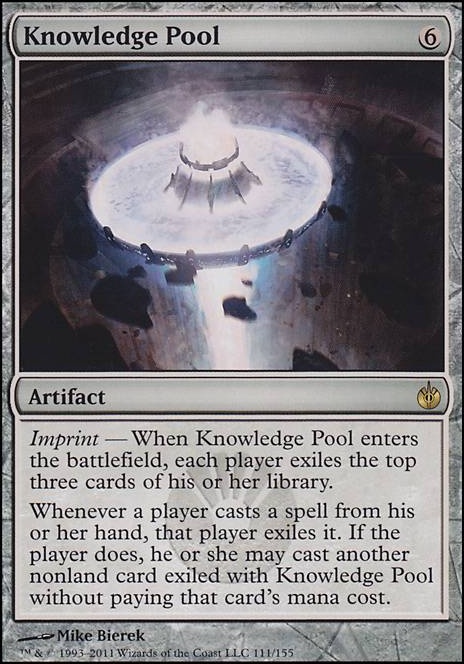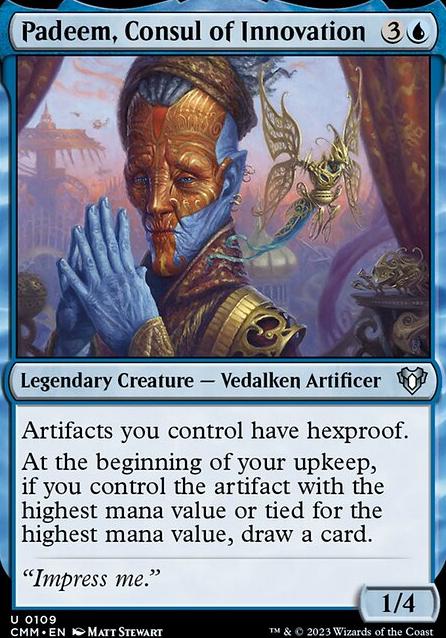Knowledge Pool is a unique stack intensive card with 2 linked triggered abilities: one etb exiling 3 cards from each library linked to the second ability & one triggered on casting from hand linked to itself. It takes some getting used to to get the most value out of this card and it presents a lot of confusing situations, thus I feel some reference is necessary.
There is a great introductory article on this site here about the pool.
A briefer summary can be found on mtgsalvation.
==========
From Gatherer
6/1/2011 : You may cast any other card exiled by Knowledge Pool, including one owned by an opponent. Any card exiled by Knowledge Pool’s enters-the-battlefield ability or its other triggered ability may be cast.
6/1/2011 : The spell a player casts from his or her hand won’t resolve if it’s exiled, even if that spell can’t be countered by spells or abilities.
6/1/2011 : If the original spell isn’t exiled (perhaps because it’s countered by another spell or ability before Knowledge Pool’s second triggered ability resolves), the rest of the ability does nothing. The player doesn’t get to cast an exiled card.
6/1/2011 : If there are no nonland cards exiled by Knowledge Pool, the original spell is still exiled.
6/1/2011 : You may pay additional costs, such as kicker costs, of the exiled card.
6/1/2011 : If the card has any mandatory additional costs, as Kuldotha Rebirth does, you must pay them in order to cast the spell.
6/1/2011 : Timing restrictions based on the card’s type are ignored. For example, you can cast an exiled creature card this way. Other restrictions, such as Spinal Embrace’s “Cast Spinal Embrace only during combat” are not ignored.
6/1/2011 : If the card you cast without paying its mana cost has an X in its mana cost, you must choose 0 as its value.
6/1/2011 : Any other abilities that trigger when you cast the original spell (for example, if you cast Emrakul, the Aeons Torn) will still trigger and go on the stack.
6/1/2011 : If multiple Knowledge Pools are on the battlefield, keep track of which cards are exiled by each of them. Whenever a player casts a spell from his or her hand:-- If all Knowledge Pools are controlled by the same player, that player chooses the order in which the triggered abilities are put onto the stack. The last one put onto the stack will be the first to resolve.-- If multiple players each control one or more Knowledge Pools, the active player put his or her triggered abilities on the stack in any order, then each other player in turn order does the same. The last ability put onto the stack this way will be the first to resolve.-- The first triggered ability to resolve will exile the original spell, then the player who cast that spell may cast one of the nonland cards exiled by the Knowledge Pool that generated that triggered ability. The abilities of other Knowledge Pools will do nothing when they resolve, as the original spell will already have been exiled.
Rules of IMPRINT
Each permanent with an imprint ability also has an ability that refers to the "exiled card(s)." These two abilities are linked. The second ability refers only to cards exiled as a result of the imprint ability, not by any other ability.
If all cards exiled by an imprint ability somehow leave the exile zone, or if a card isn't exiled by an optional imprint ability, or if the ability failed to exile a card because it was countered, then it is possible for an imprint ability to have no exiled card to refer to. In this case, the linked ability associated with the imprint ability has no card values to refer to and will only do as much as possible. It may do nothing at all.
If a permanent with an imprint ability leaves the battlefield and then returns to the battlefield, it is a new object. It has no association with any cards it exiled during its previous existence.
======
Relevant rulings for Mirage Mirror interaction with the pool:
RE: linked ability part of imprint keyword
607.4. If an object acquires a pair of linked abilities as part of the same effect, the abilities will be similarly linked to one another on that object even though they weren’t printed on that object. They can’t be linked to any other ability, regardless of what other abilities the object may currently have or may have had in the past.
This essentially means when it turns back into itself at EoT all the cards that went into it remain in exile, unable to be cast again even if it turns back into the pool later since the game treats each transformation as a new set of linked abilities.
======
Relevant ruling for pool leaving the battlefield while trigger is on the stack:
112.7a Once activated or triggered, an ability exists on the stack independently of its source. Destruction or removal of the source after that time won’t affect the ability. Note that some abilities cause a source to do something (for example, “Prodigal Pyromancer deals 1 damage to target creature or player”) rather than the ability doing anything directly. In these cases, any activated or triggered ability that references information about the source because the effect needs to be divided checks that information when the ability is put onto the stack. Otherwise, it will check that information when it resolves. In both instances, if the source is no longer in the zone it’s expected to be in at that time, its last known information is used. The source can still perform the action even though it no longer exists.
The ability will still see the exiled cards even if the pool isn’t on the battlefield.






